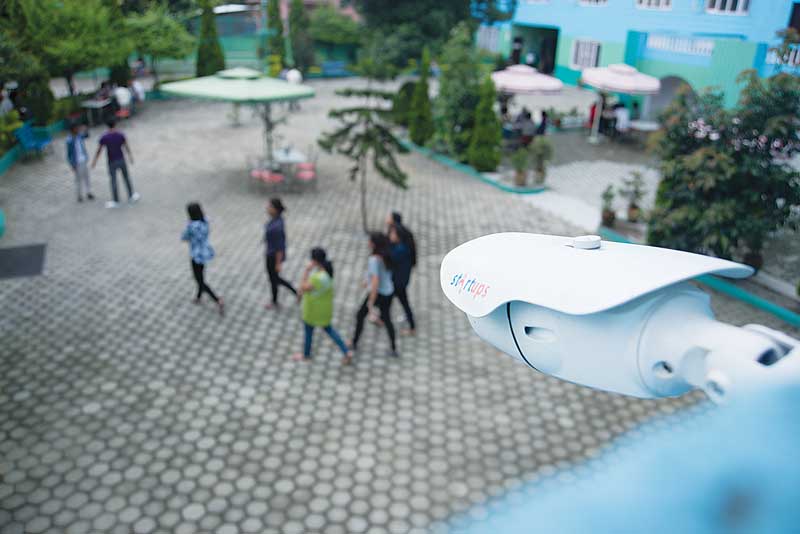Always keeping an eye
CCTVs have given us extra eyes allowing us to monitor several locations simultaneously and stay on top or our surveillance game.

“This place is under CCTV surveillance.” These banners today have outgrown the number of “Beware of Dog” plates. Breaking its stride in the electronics’ age, keeping a watch through Closed Circuit Television (CCTV) has become more prolific. As costs decline, accuracy of machines, dexterity, unhindered alertness and broader reach have propelled the use of surveillance systems anywhere from offices, larger compounds to everyday households. Having eyes on you property even when you are away is a great assurance that money can afford. From heavily fortified government facilities to closely monitored entrances and camera rigged porches, we look at the different types of CCTV currently available and the features that one must look at while shopping for CCTV systems.
Dome Cameras:
Best for: Shops and stores
One of the most common forms of CCTV is the dome camera. Deriving its name from the shape of the camera, the camera is often static and is focusing at a particular direction. However, the range of vision is often unclear to onlookers which makes it ideal in grocery stores or fixed placements at the compound walls of private facilities.
Bullet Cameras:
Best for: Cash counters, Entrance Gates.
Keeping camera names descriptive, the bullet camera also gets its name from its appearance. Shaped like a bullet, the lenses peep through one end of the barrel and are usually point focused. These cameras give better detail and quality of picture than the dome cameras but have limited scope. Corner edges, counters and more high priority locations could be fitted with these cameras.
C-mount:
Best for: Large compounds, Alleys and Streets
The C-mount cameras specialize in lenses. The camera is capable of equipping multiple types of lenses based on the setting and the field of vision required. This lens interchanging feature comes in handy when you have specific viewing requirements for particular locations. For example, you can switch to lenses that give you vision at distances over 10 metres at large open spaces.
PTZ:
Best for: Covering a wider angle, Manually control
Panning-Tilt-Zoom in long form is a genre of cameras that extend maneuverability to the static CCTVs. Clearly suggested by the name, the degrees of freedom offer panning in any direction, tilting to any angle and the feature of closing in or getting a zoomed out view. Both dome and button cameras of higher specification include these features. Some are even capable of delay based tracking or motion based tracking.
Wireless:
Best for: Wirefree installation, Mobile surveillance
Encompassing everything from IP based transfer of simple radio transfer or even stored surveillance (the latter of which isn’t highly likely), The autonomous camera is battery powered and can be placed anywhere at anytime without any tethers. Think of it like a GoPro that’s constantly feeding the footage. We can use it in dynamic areas where constant reposition might be necessary or on drones, cars or UAVs.
We sense a need to stay connected on the go wherever we may be. You can take a peek at your main gate while you are on a vacation through your smartphone or computer.
Features of CCTV
Network: Today, we live in a connected world and from the standpoint of technical intricacy, we sense a need to stay connected on the go wherever we may be. Through IP based cameras or CCTV monitoring servers that connect to the internet this would be readily possible. What this offers in return is you can take a peek at your main gate while you are on a vacation through your smartphone or computer.
Weatherproof: Not all cameras are built for rough and tough conditions. There are economical versions designed to sit nice and easy mounted on cosy walls of storefronts or corridors. Taking them out in the open and weathering them to heat, cold and water would quickly cease the unit. Hence, for outdoor usage or installation in abnormal working conditions, compliant devices with sufficient weatherproof signatures are recommended
Nightvision: Through Infrared (IR) technology and other later versions of night vision tech, cameras stay alert and keep images sharp even during the dark . Since we are more susceptible to crime during the dark, nearly all CCTV cameras come equipped with night vision of subsequent lighting compensation.
HD: High definition is the name of the game in multimedia. During its inception, lack of proper lens technology and high speed data transfers meant that camera resolution were pretty low. Today things have changed and the cameras can muster HD videos quite easily.
Vandalproof: This goes without saying, in case or criminal activities or vandal intents, cameras need to stay alert, up and running, While tamperproof placement is a given, your cameras should be able to withstand a certain degree of riot. Quality checks and standards ensure that your camera lenses and body are tolerant to a certain degree of tampering.


